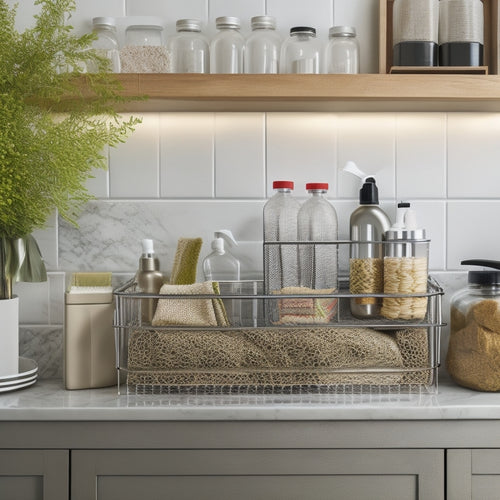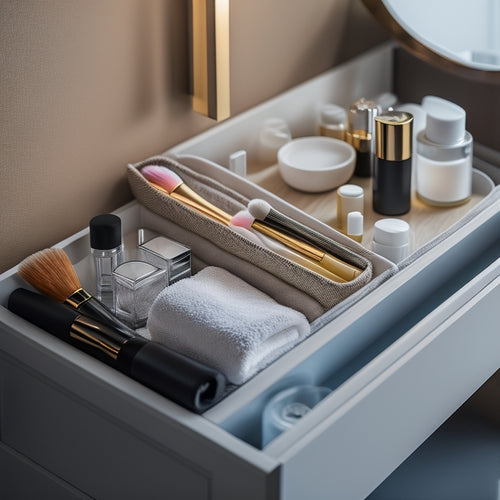
10 Tips to Declutter and Organize Countertops
Share
You're about to transform your kitchen into a clutter-free oasis! Start by purging everything from your countertops and sorting items into keep, donate/sell, and discard piles. Designate zones for essential items, group similar items together, and choose containers that fit your specific needs. Utilize vertical storage space, and hide clutter with decorative items. Implement a daily maintenance routine to prevent clutter buildup, and add a touch of aesthetics to create an inviting kitchen space. With these tips, you'll be well on your way to a kitchen that's both functional and stylish - and there's more to discover to take your countertop organization to the next level!
Key Takeaways
• Remove everything from countertops to sort items into keep, donate/sell, and discard piles, and be honest about item usage.
• Designate zones for essential items, grouping similar items together and creating functional stations for tasks like baking or coffee-making.
• Choose the right-sized containers based on specific needs, labeling them effectively for organization and matching them to stored items.
• Utilize vertical and stackable storage to reclaim counter space, maximizing shelf space and using shelf dividers, bins, and pegboards.
• Establish a daily routine for countertop maintenance, wiping down surfaces, putting away items, and replenishing supplies daily to prevent clutter buildup.
Start With a Purge
Remove everything from your countertops and sort items into three piles: keep, donate/sell, and discard. This purge is essential to clearing your countertops and creating a more organized space.
As you sort, be honest with yourself about each item. Ask, 'When was the last time I used this?' or 'Do I truly need this?' Be ruthless – if you haven't used it in the past year, it's likely taking up valuable space.
Emotional attachment can be a significant obstacle in this process. It's natural to feel sentimental about certain items, but remember, the goal is to create a functional and peaceful space. Take a deep breath and let go of items that no longer serve you.
Clearing your countertops requires a clearing mindset – a willingness to release the old and make way for the new. By letting go of clutter, you're making room for a more organized, efficient, and innovative you.
Designate Zones for Essentials
Now that you've purged your countertops, it's time to designate zones for the essential items you've decided to keep, grouping similar items together to create a functional and efficient workspace.
To maximize your workstation flow, create functional stations for each task or category of items. This will help you stay organized and focused while cooking, preparing meals, or even doing homework.
Here are some zones worth exploring:
-
Baking Station: Group baking essentials like flour, sugar, and baking powder near the mixer.
-
Coffee Bar: Designate a zone for your coffee maker, mugs, and coffee beans.
-
Snack Station: Store healthy snacks like fruits, nuts, and granola bars near the fridge.
-
Meal Prep Zone: Allocate a space for meal prep essentials like cutting boards, knives, and utensils.
-
Homework Hub: Create a zone for homework supplies, like pens, paper, and a calculator, near a comfortable workspace.
Choose the Right Containers
When choosing containers to organize your countertops, you'll want to select ones that fit your specific needs.
It's important to take into account the size of the container, ensuring it's not too big or too small for the items you plan to store.
Container Size Matters
You'll be amazed at how drastically the right-sized containers can transform your countertop's cluttered landscape. It's important to choose containers that fit your items perfectly, leaving minimal empty space. This will prevent clutter from accumulating again and make the most of your storage space.
To make sure you're selecting the best dimensions, avoid these common measuring mistakes:
- Not measuring the item to be stored
- Not considering the container's material and its impact on size
- Measuring only the item's width and length, forgetting about height
- Not leaving space for easy removal and replacement
- Failing to account for the container's lid or handle size
Match Container to Item
By selecting containers that perfectly match the items you need to store, you can secure a clutter-free countertop that's both functional and visually appealing. When choosing the right containers, consider the items you're storing and the space available.
For instance, if you're storing small kitchen gadgets, opt for compact containers with separate compartments to keep each item organized.
For larger items like cookbooks or appliances, select containers with a more substantial capacity. Don't be afraid to mix and match different container styles to create a unique storage system that suits your needs.
For example, you can pair glass containers with wooden crates to add a touch of rustic charm to your countertop.
Employing effective matching strategies is vital to achieving a harmonious and organized space. Assess the shape, size, and material of each item and select containers that complement these characteristics.
Labeling Is Essential
To guarantee that your carefully selected containers remain functional and organized, labeling them clearly is essential, as it helps you quickly identify what's inside and maintain a clutter-free countertop. Without clear labels, you'll struggle to find what you need, leading to frustration and disorganization.
Overcoming labeling challenges requires a thoughtful approach. Here are some tips to help you create an effective labeling system:
-
Use a consistent labeling style throughout your containers to create a cohesive look.
-
Choose labels that are easy to read and understand, avoiding ambiguous abbreviations.
-
Consider using color-coding to categorize similar items or to distinguish between different types of contents.
-
Make sure labels are durable and can withstand regular use and cleaning.
-
Keep labels concise, focusing on the essential information you need to know at a glance.
Utilize Vertical Storage Space
Now that you've got the right containers, it's time to think vertically!
You can reclaim valuable counter space by utilizing the often-wasted space above your countertops.
Maximize Shelf Space
You can greatly increase your available storage capacity by making the most of your shelf space, which often gets underutilized in many kitchens. Optimizing space is key to maximizing shelf space, and it starts with evaluating your current storage needs. By rethinking how you use your shelves, you can create a more efficient and organized space.
Here are some tips to help you maximize your shelf space:
-
Install shelf dividers to separate and categorize items, making them easier to find and access
-
Use baskets or bins to store small items like spices, oils, or snacks
-
Place frequently used items in easy-to-reach locations
-
Consider installing a pegboard for hanging items like utensils or pots
-
Label each shelf or category to maintain organization and make it easier to restock
Use Stackable Containers
By utilizing stackable containers, you can effectively tap into the often-wasted vertical storage space above your countertops, freeing up valuable real estate for more essential items. This clever storage solution allows you to maximize your countertop's vertical space, keeping frequently used items within easy reach while keeping clutter at bay.
Stackable drawers or containers offer versatility, enabling you to store a variety of items such as spices, oils, or cleaning supplies. You can also label each container to make certain everything has its designated place, making it easy to find what you need in a flash.
Another benefit of stackable containers is their adaptability; you can easily add or remove containers as your storage needs change.
When choosing stackable containers, consider the size, material, and design that best suits your countertop's style and your storage needs. Look for containers with smooth edges and a sturdy build to guarantee they can withstand frequent use.
Install Upright Racks
Take advantage of the often-overlooked vertical space above your countertops by installing upright racks, which can hold everything from cookbooks and utensils to infrequently used gadgets and appliances. This is an excellent way to maximize your kitchen's storage capacity and keep your countertops clutter-free.
Here are some ideas for utilizing upright racks:
-
Spice Organization: Install a rack near your cooking station to store frequently used spices, oils, and condiments, keeping them within easy reach.
-
Appliance Placement: Mount a rack above your countertops to store infrequently used appliances, such as slow cookers, blenders, or stand mixers, freeing up valuable counter space.
-
Store cookbooks, recipe cards, or kitchen-themed decorative items on a rack near your cooking station.
-
Use a rack to store utensils, such as pots, pans, or colanders, keeping them organized and easily accessible.
-
Install a rack near your sink to store dish soap, sponges, and other cleaning supplies, keeping them out of the way but still within reach.
Group Similar Items Together
Cluttered countertops often result from a lack of categorization, making it essential to group similar items together in designated zones to maintain a sense of order. By doing so, you'll create a more organized and functional space. This process is called category clustering, where you gather items that serve a similar purpose or belong to the same category.
For instance, group all your baking supplies, such as flour, sugar, and baking powder, in one area. This technique is also known as similarity sorting, where you categorize items based on their characteristics or functions.
To implement this effectively, start by identifying the categories that make sense for your countertop. You might've zones for cooking, baking, coffee-making, or food preparation. Once you've determined your categories, group the corresponding items together in their designated zones. This will help you maintain a sense of order and make it easier to find what you need when you need it.
Assign a Home for Each Item
Now that you've grouped similar items together, it's time to assign a home for each item.
You'll need to designate zones on your countertop for specific tasks or activities, and identify the essential items that will live in each zone.
Designate Zones
Assign a specific area on your countertop for each item, creating zones that make sense for your daily routines and habits. This will help you maintain organization and reduce clutter. By designating zones, you'll create a sense of structure and flow on your countertop, making it easier to find what you need when you need it.
Here are some zones to contemplate:
-
Coffee Station: Designate a spot for your coffee maker, coffee beans, and favorite mugs.
-
Baking Zone: Assign an area for your mixing bowls, baking utensils, and recipe books.
-
Food Prep Area: Create a zone for your cutting boards, knives, and utensils.
-
Breakfast Nook: Designate a spot for your toaster, blender, and breakfast essentials.
-
Counter Flow: Reflect on the flow of your countertop and create zones that make sense for your daily routines, ensuring a smooth shift between tasks.
Identify Essential Items
With your zones established, you can start identifying the essential items that belong in each area, and then assign a specific home for each item, ensuring everything has a designated place where it can be easily found and used. This will help you maintain a clutter-free countertop and reduce stress in the kitchen.
Start by categorizing your daily essentials, such as coffee makers, toasters, and blenders, into groups like 'breakfast station' or 'baking zone'. This will give you a clear idea of what items you need to prioritize and allocate space for.
Next, consider your kitchen priorities, like meal prep or cooking frequency, to determine which items deserve prime real estate on your countertops.
Assign a specific home for each item, taking into account its frequency of use and accessibility. For instance, frequently used spices can be stored in a convenient spice rack near the cooking zone, while less-used items can be stored in upper cabinets or on higher shelves.
Keep Frequently Used Items Accessible
You'll find it easiest to prep and cook when your most frequently used kitchen items, like olive oil, spices, and utensils, are conveniently within arm's reach. This is where the concept of 'quick grab' comes into play. By keeping your Daily Essentials within easy reach, you'll save time and reduce clutter.
Here are some essentials to keep accessible:
- Olive oil and cooking sprays
- Frequently used spices and seasonings
- Utensils like tongs, spoons, and spatulas
- Kitchen towels and oven mitts
- Trash can and recycling bin
Hide Clutter With Decorative Items
By incorporating decorative items that serve a functional purpose, such as vintage spice racks or ceramic utensil holders, you can cleverly conceal clutter and maintain a sense of organization on your countertops.
These decorative items not only add a touch of style to your kitchen but also provide a clever way to hide clutter. Consider using decorative trays with hidden compartments to store small items like spices, oils, or condiments. This will keep them out of sight while keeping them easily accessible.
Another innovative approach is to use decorative containers with lids or doors that can be used to store items like coffee pods, tea bags, or snacks. These containers can be placed on countertops, adding a decorative element while keeping clutter at bay.
Implement a Maintenance Routine
To keep your newly organized countertops clutter-free, establish a daily routine that sets aside a few minutes to quickly wipe down surfaces, put away items after use, and replenish supplies. This daily maintenance will prevent clutter from building up and keep your countertops looking their best.
To maintain your organized countertops, incorporate the following daily habits into your routine:
- Set aside 10 minutes each day to tidy up and put away items
- Wipe down surfaces with a damp cloth to remove crumbs and spills
- Put away dishes and utensils immediately after washing
- Restock supplies and ingredients as needed
- Take a few minutes to review your countertops and adjust your layout as needed
In addition to your daily habits, schedule weekly reviews to assess your progress and make adjustments as needed. This will help you stay on track and maintain your organized countertops.
Add a Touch of Aesthetics
Now that your countertops are organized and clutter-free, it's time to add some visual appeal to make the space truly inviting. You've worked hard to declutter and organize, so why not take it to the next level with a dash of style?
Start by selecting a color scheme that complements your kitchen's overall aesthetic. This will help you choose decorative accents that tie the space together. Consider adding a statement piece, like a vibrant vase or a decorative canister, to draw the eye to a specific area of the counter.
Don't be afraid to mix and match different textures, like glass, wood, and metal, to add depth and visual interest. Finally, balance your decorative accents with functional items, like a utensil holder or a paper towel roll, to maintain a sense of functionality.
Frequently Asked Questions
How Often Should I Clean and Declutter My Countertops?
You should establish daily habits like wiping down countertops after meals and implement seasonal purges to maintain a clutter-free space, ensuring your countertops remain organized and functional.
Can I Use Baskets or Bins With Lids to Hide Clutter?
"Life's a treasure hunt, and you're the master excavator! Yes, you can use baskets or bins with lids to hide clutter, creating decorative storage with hidden compartments that keep your countertops tidy and your sanity intact."
What if I Have Limited Storage Space in My Kitchen?
If you're working with limited kitchen storage space, you'll want to prioritize ideal shelving, invest in compact appliances, and utilize space-saving gadgets to create efficient layouts that maximize every inch of available room.
How Do I Organize Countertops With Multiple Users?
"When you're sharing countertops with multiple users, designate personal zones with labeled bins and baskets, ensuring each user has their own space, while maintaining shared spaces for communal items, like coffee makers or toasters."
Can I Use Countertop Organizers With Non-Standard Size Counters?
You're wondering if countertop organizers can adapt to your non-standard size counters. Yes, customized solutions exist! Employ precise measuring techniques to tailor systems that fit your unconventional spaces, ensuring adaptive designs that maximize functionality.
Related Posts
-

Under-Sink Storage Solutions for Urban Living
Under-sink areas in urban apartments can change from cluttered voids into efficient storage havens with smart solutio...
-

Modern Bathroom Drawer Organizers With Dividers
Modern bathroom drawer organizers with dividers help you make the most of your space and keep your essentials tidy. T...
-

Get Your Quirky Designs Now
Express your individuality with vibrant, one-of-a-kind designs that celebrate self-expression and quirky humor. Disco...


